Simon Scott
31st May 1956 -15th July 2021
Andrew Lindsay reflects on his great friend Simon Scott, and their fun times together over the last 35 years.
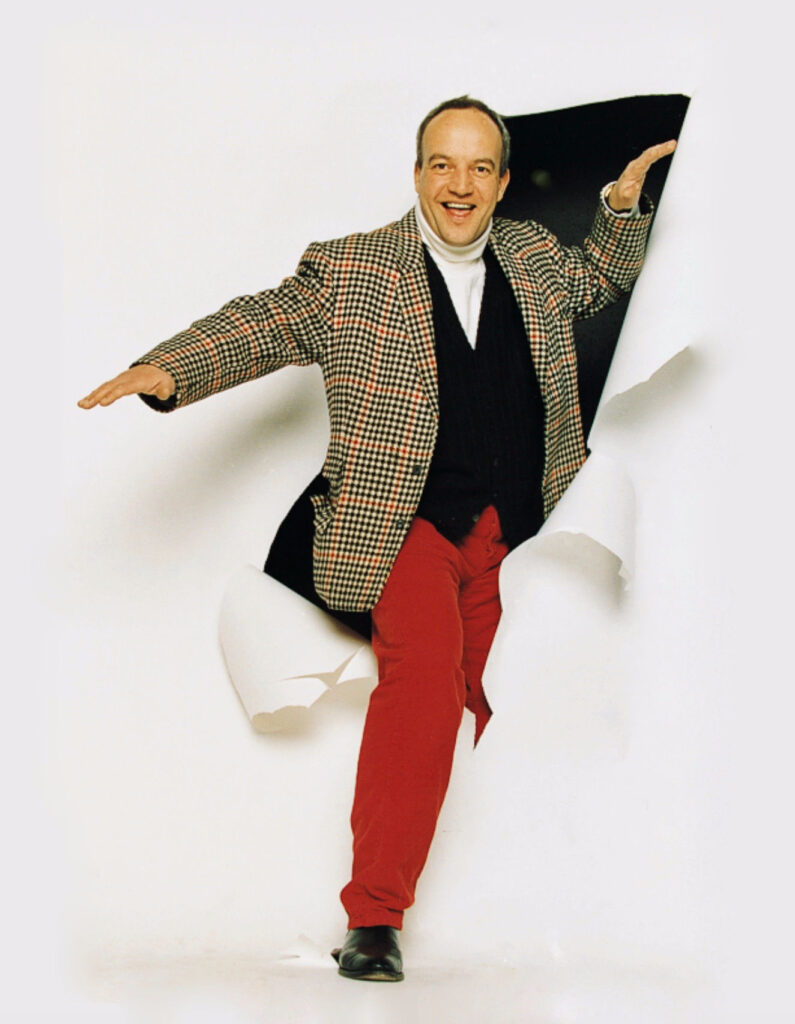
Simon was my creative partner, business partner, dearest friend, confidant and regularly an exasperating bugger. He used to joke that ours was the only relationship he had managed to maintain. Jane Scott called me his ‘second wife’.
We met in 1985, I was creative director of Ash Gupta Advertising and he was a copywriter at CDP Marr. We met as we were both involved in tutoring D&AD student workshops. Although quite different characters, we immediately hit it off and cemented our friendship over large gin and tonics at the Caledonian Hotel.
As fate would have it, we were thrown together at Hall Advertising the following year. I had already decided to move to Australia and was waiting for my paperwork to come through. Whilst waiting Jim Downie invited me to work at Halls. Simon had moved to Halls and was now Jim’s copywriter. The three of us shared an office, but Jim lived in wall-to-wall meetings, so Simon and I worked on various jobs together.
I absolutely adored working with Simon. He was full of fun, frighteningly bright and without doubt the most talented writer I have ever come across. His prose was effortless, he seldom needed to change a word, but if required he was willing to write and re-write over and over to make his copy fit my layout. I remember a lovely campaign for the Gleneagles Hotel that he re-wrote 18 times until if fitted perfectly into the full-page advert. By that time we could both recite it word for word – I still remember most of it.
After eight months I finally moved to Australia, but I did regret no longer being able to work with Simon. For all sorts of reasons things were not going too well down under, and after a year I came back to Edinburgh. I had a lunch with Jim Faulds who I had previously met a couple of times. Over lunch he offered me the creative director’s position at his recently formed agency, Faulds Advertising. We agreed that if I was to accept I could recruit my own team.
The first person I spoke to was Simon; I saw a huge opportunity to build something special if he were to join me there. Over lunch I did my best selling job on him, knowing he already had a great job at Halls which was the preeminent advertising agency of its day.
I asked Simon what it would take to persuade him to move and he said “I’ll have what you have.” Thus we became joint creative directors earning exactly the same salary, owning the same number of shares and so forth.
Getting Jim on board was interesting. I arranged for Simon to meet Jim for a drink so Jim could see what he was getting for his money. I met with Jim the next day and I could see he was perplexed about hiring this ex-public schoolboy, ex-Sandhurst cadet and author of the biography of Hercules the bear as well as the history of the Forth Bridge. (Simon was always happy to tell you that the Forth Bridge book had been in the top ten sellers list in Scotland.)
Jim is a proud West of Scotland working class bloke and I think Simon stood for most of the things Jim didn’t. But to Jim’s credit he gave me the go-ahead, and Simon joined me at Faulds. A lot of people in the industry were incredulous that he made the move (Faulds didn’t have a great reputation for creativity at the time) but history has proved he made the right decision.
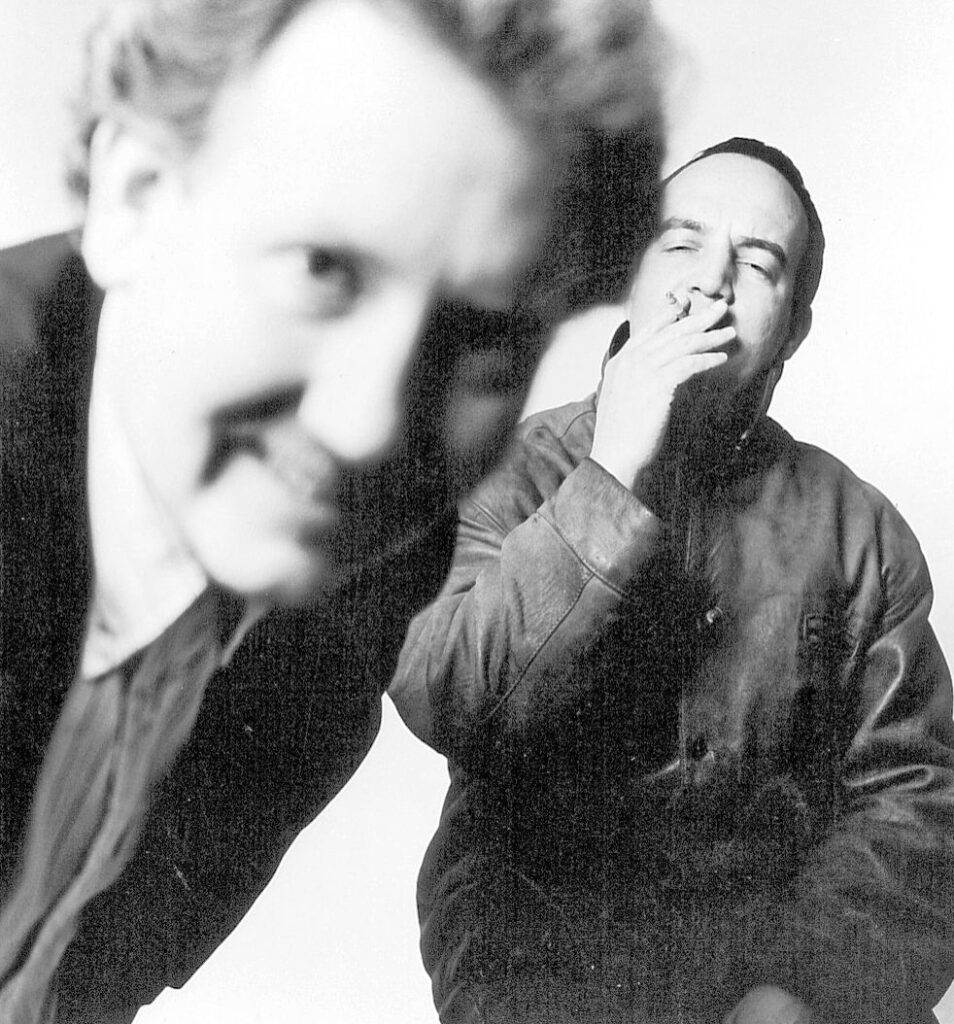
Simon joined me at Faulds – a hugely successful time.
Jim and Simon became huge friends. Simon loved to big up Jim’s working class credentials. In an interview with a journalist Simon waxed lyrical about how Jim left school at sixteen so he could help to fund his siblings through University; which was total fiction. He also recounted how Jim had a scotch pie and a can of diet Irn Bru every day for lunch; this was also a total fiction.
I can truthfully say that Simon and I never fell out or had a serious argument. The nearest we came to having ‘three rounds in the car park’, as he used to say, was him getting in early to book his holidays the week between Christmas and New Year. He put in his request in March of that year. We had agreed to take that week off in turns; and it was my turn that year. I was not best pleased.
When I joined Faulds there were seven employees; Simon was number nine. In the eight years we were there the business grew to about 120 staff, we won a legion of blue chip accounts and a barrow-load of advertising awards; and we also hired some fabulously talented people.
Pitching for new accounts was a scary business as Simon flatly refused to rehearse; it spoilt his spontaneity. That meant that when he stood up to present nobody knew what was going to come out of his mouth. Sometimes I think he didn’t know either.
I remember him standing up and telling a parable about a small boy in an African village walking up to an old, blind man who was sitting cross-legged carving an elephant from a lump of wood, the boy asked how he knew how to carve an elephant when he was blind? The old man replied it was simple that all he had to do was to cut away anything that wasn’t elephant. The room was enthralled, the clients waiting to hear how this related to their business. It didn’t. Simon just moved on seamlessly to present the creative work, leaving the clients completely mystified.
Sometimes Simon’s pitching methods worked, and other times they didn’t.
We were pitching for a large chain of newsagents and it was a particularly challenging brief. We had only ‘cracked’ it the evening before, and had worked through the night to complete the pitch. At the meeting Simon stood up and began his presentation with the words, “This has been a nightmare!” I could see the account men sliding down in their seats. Simon went on to say we couldn’t find a solution to the client’s problem until the previous evening when he was lying in his bath and suddenly, “Eureka!”. The answer had come to him, and here it was. The client was very impressed that we had worked up to the very last minute and to come up with a stunning solution. We won the business.
At the very next pitch Simon tried the same tactic – nightmare, bath, the Eureka moment.
We lost the pitch. The client said he wouldn’t go with an idea that was chucked together in an evening.
Over the years Simon’s showmanship knew no bounds; he sang at pitches, he danced, he chopped vegetables, he pleaded and he even got down on his knees and begged.
Much of the time it worked, we won more than we lost, and the business grew, but Simon never became big-headed or believed our own BS. He regularly said “This is only advertising, it’s not curing cancer.” And when asked what he did for a living he would say, “Shit-shoveler to the gentry”.
We were extremely proud of much of the work we created. Some have mentioned a commercial we created for the Scottish Tourist Board called ‘When will you go?’. It featured a music track called Wild Mountain Thyme, reinterpreted by a band called the Silencers.
At that time tourism adverts were all about location and scenery, and pretty bland. However, our vision was to treat Scotland as a brand; like you would do with a pair of Levi’s. We thought that a trip to Scotland should be all about romance. So we created a story of a girl making her way through Scotland to find her man. It also featured the poetry of Norman McCaig, and somehow we persuaded him to appear and recite in the commercial. (“Only men’s minds could have unmapped into abstraction such a territory.”) To sell in the commercial we created a montage of stills and clips of films that, when put together, gave a feeling of how the finished ad would look.
The company who made this ‘animatic’ for us was run by John Hogg and George Barr, and they saw an opportunity of getting the contract for final film. So they invited us to lunch to meet Bill Forsyth, director of ‘Local Hero’ and ‘Gregory’s Girl’. They had him shown the script and he was keen to get involved. We had already drawn up a list of potential directors; and although we were excited to meet Bill, we made it clear this was just a chemistry meeting. He would be one of the contenders. We had a pleasant enough lunch. But it soon became clear that Bill wanted to make the commercial more of a comedy. Our vision was of a beautifully shot, romantic story.
So after talking to a few directors, we eventually chose the ‘Douglas brothers’; whose stunning photographic work was exactly what we wanted for our film.
I remember soon after, crossing Tottenham Court Road after coming out of a meeting with the brothers, when Simon got a phone call. It was George Barr saying that Bill Forsyth was already casting for our commercial, and wanted to meet to show us some potential actors.
So the most famous movie director to come out of Scotland at the time, was casting a film that we had already given to someone else! Oh dear. Simon was trying to shout down the phone above the traffic noise, saying that we had already given the job to another company. George told us that we needed to tell Bill. We responded that was George’s problem, as he had not told Bill that we were looking at other directors.
We didn’t hear any more until weeks after the commercial was completed and on air. Out of the blue Simon received a letter from Bill Forsyth, which he no doubt had spent days penning. He had poured as much vitriol into the letter as possible. His ire was directed fully a squarely at Simon, claiming he had stolen his ideas. John and George were described in the letter as ‘bottom feeding minnows’ and I was apparently a ‘cold fish’. He mentioned legal action and claimed that we would never work ‘in this town again’.
We never heard any more. Simon kept the letter in a frame.
Simon was extremely knowledgeable. He could engage in meaningful conversation about most subjects; a lot of this came from being an avid reader. At ten o clock each morning he would tuck his newspaper, or copy of the New Yorker magazine, under his arm and head off to the gents, where he would spend the next 30 or 40 minutes.
Simon’s great passion was antiques, which he loved to buy and sell. He was well known in every saleroom in Edinburgh and left bids at every sale. He could ferret out a bargain and usually find a buyer. He had lock-ups and garages filled with all manner of items he had bought.
On one overnight stay in London we went to a fish restaurant called Geals in Kensington High Street. The specialty of the house was fish and chips and champagne. After a few glasses of bubbly we had a conversation about how this format would go down a storm back in Edinburgh. By the end of the evening we had decided to go into the restaurant business. We had a few more conversations about this but I lost interest and expected that Simon had done the same.
And then one Monday morning he announced to me that over the weekend he had bought nine whales. The whale models were sold by the Scottish Museum collection, and had been stored away for many years. He had paid £800 for the lot which he told me was a bargain. The whales were made from plaster and were designed in proportion to their size in real life; the smallest was about two feet long and the largest about twelve feet long. They were in poor condition and Simon planned to have them renovated. I was interested to know why he bought them and he said for the ‘fish restaurant’. By this time I had completely forgotten our inebriated plan. So Simon rented a small basement shop in Dundas Street and hired the services of a set painter from the Lyceum Theatre that he vaguely knew. Thee whales were duly made to look like new. He eventually found a buyer and made a sizable profit from the sale. When I asked him what the buyer intended to do with the whales, he told me they were going to decorate a fish restaurant they were planning to open!
Whenever we went on a film location or foreign trip, the first thing Simon would be looking for was a flea market. On various trips he bought a gold-plated Leica camera that had belonged to a WW2 German officer, five vintage Rolex watches and a famous matador’s cape complete with a letter of authenticity.
In 1995 we began to become disillusioned with Faulds, mainly due to the financial disparity we felt with other shareholders who earned considerably more, but contributed considerably less (in our view) to the growth of the business. We had discussions about the situation but we could see nothing was going to change.
We decided we had helped to build a successful business so why not do it again?
We spent a great deal of time planning the new venture but we realised that we needed a brilliant account man and a planner to complete our team. Ian McAteer was due to become the next MD of Faulds. We had worked closely with him since his arrival from Saatchi and Saatchi in London four years earlier. We went out for a sandwich with Ian to a small park near the office, and put our plan to him. He was extremely sceptical, and for some weeks tried to convince us to stay and fight our corner. But he eventually succumbed and threw his hat in with us. We then approached Mark Reid who was the deputy-planning director at Faulds, and I guess he had less to lose, and quickly agreed.
So The Union was born on the 1st March 1996. The first year was dire, we all had big outgoings and we were paying ourselves far too much for a start up. Simon and I mortgaged our houses and we all took out bank loans, but we burnt through the cash rapidly. Simon put more cash into the business, and without that I don’t think we would have survived.
Jim Faulds was a great friend, but turned out to be a formidable adversary. As Simon would say ‘he had us stitched up like kippers’ (or ‘trussed up like a Christmas turkey’) with non-compete contracts and the like. From being the ‘big boys on campus’. we were struggling to win any client accounts. We worked twelve hours a day, seven days a week. From working for clients with huge budgets, we were now pitching for tiny pieces of business.
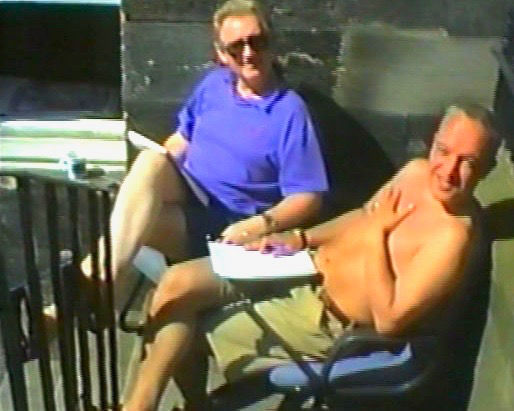
Weekend working; seven days a week, twelve hours a day.
The most depressing event had to be our first Christmas lunch, which took place in the pub across the road from our rented office. It was sausage and mash, a beer, and then back to work by 2pm.
They were the worst of times, but they were the best of times.
Gallows humour was the order of the day. Having Simon as part of the team kept life interesting. ‘Careers in tatters… men with big futures behind us…’ were a couple of his cheerful quips.
But it was at the same time good fun and a huge adventure, and none of us doubted we would succeed.
The second year changed our fortunes as we finally won a decent piece of business. Scottish Courage gave us their trade account. Then the real turning point for the business was winning the newly-launched Standard Life Bank. This was a telephone bank and a forerunner of internet banking. Simon took most of the credit having come up with the idea of using the extended thumb and pinkie hand-signal ‘I’ll call you’ device for the bank’s advertising.
We did an excellent job on Standard Life Bank and when Jim Spowart, the CEO, moved on to form another new bank for Halifax, we moved with him. Intelligent Finance, as we named it, gave us the financial platform to grow The Union.
In our second year we moved offices to a small industrial style building in Rodney Street. It had a pretty ugly brick built frontage with a large single pane window. Simon got a sign painter to paint a huge ‘UNION’ across the front, above the window. It was quickly pointed out that we had broken every planning law in doing this; but Simon completely ignored all this negativity and thankfully the planners never took us to task.
The next move in 2002 was to the church at Inverleith Terrace, where The Union is still housed today. Simon had been to the church for tai chi classes; one of his quickly passing phases. We were offered the church by a contact of his and he was very excited by the prospect of putting The Union in there. The four of us went along to view the church and I think we didn’t get past what is now reception before we had agreed this was the place for us.
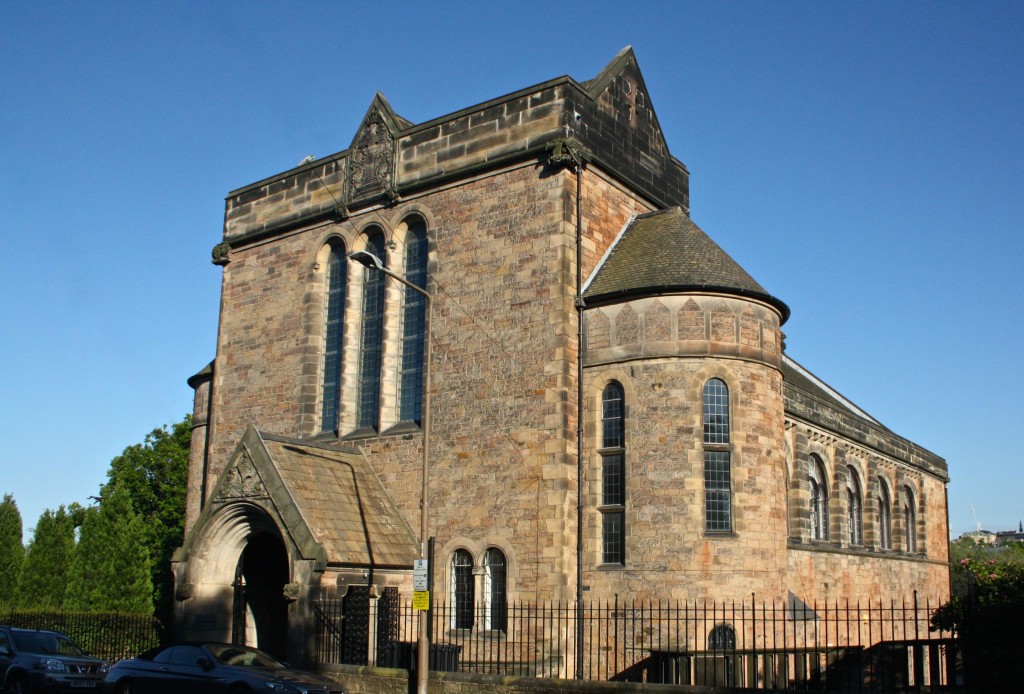
We knew immediately that the church was the place for us.
Simon’s eclectic taste soon began to transform the space with a wooden canoe being delivered one day with no one knowing why; a large Japanese warrior’s mask; and then four 6 metre square portraits of heads followed. Other random artefacts came and went, including a massive Victorian hustings poster mounted on wood, calling on voters to vote for a Tory candidate for Queen and Union. This lived in our office for years.
Simon didn’t like authority too much. Perhaps because of his time at Sandhurst. When we were unfairly taken to an industrial relations tribunal and he was being cross-examined by the opposing lawyer, he had an outburst, asking ‘Is this some kind of Stalinist show trial?’ and asserting that ‘All the employment lawyers I know drive Aston Martins!’. In his written judgement, the judge called Simon ‘probably the worst defence witness’ he had ever encountered.
Simon came to the filming of most of our commercials; although he was never that interested in looking through the camera lens or checking performances. He was normally holed up somewhere at the back of the set with a new best friend where he would hold court usually singing show tunes or telling stories.
On one shoot in Cape Town he got friendly with a guy who worked in the film industry half of the year and created bespoke safaris for the other half. They became friends and Simon commissioned him to create a safari for him and his family. They duly went on the safari and while on the trip Simon decided he wanted to move to South Africa; and he promptly bought a farm there and then.
Simon was a ‘shoot from the hip’ kind of guy. He would get excited about an idea and just do it. When he returned from Cape Town he invited me out for a drink and gave me the news that he was leaving The Union. To be fair I had a good idea that he had been bored with the Scottish advertising merry-go-round for a while.
He stayed in South Africa for a few years but his boys couldn’t settle there so he put them to school back in Edinburgh. His wife Jane then found it difficult to live on a different continent from Tom and Jack, and eventually they sold the farm and returned to Scotland.
He got involved in a few different ventures including a one-man show at the Open Eye gallery of objects and typography, an antiques business called That Wow Thing, and latterly a design and marketing consultancy called The Gifford Project.
I still used Simon on an ad hoc freelance basis and still loved working with him. We met for lunch regularly; by now he had given up the demon drink but was still as entertaining.
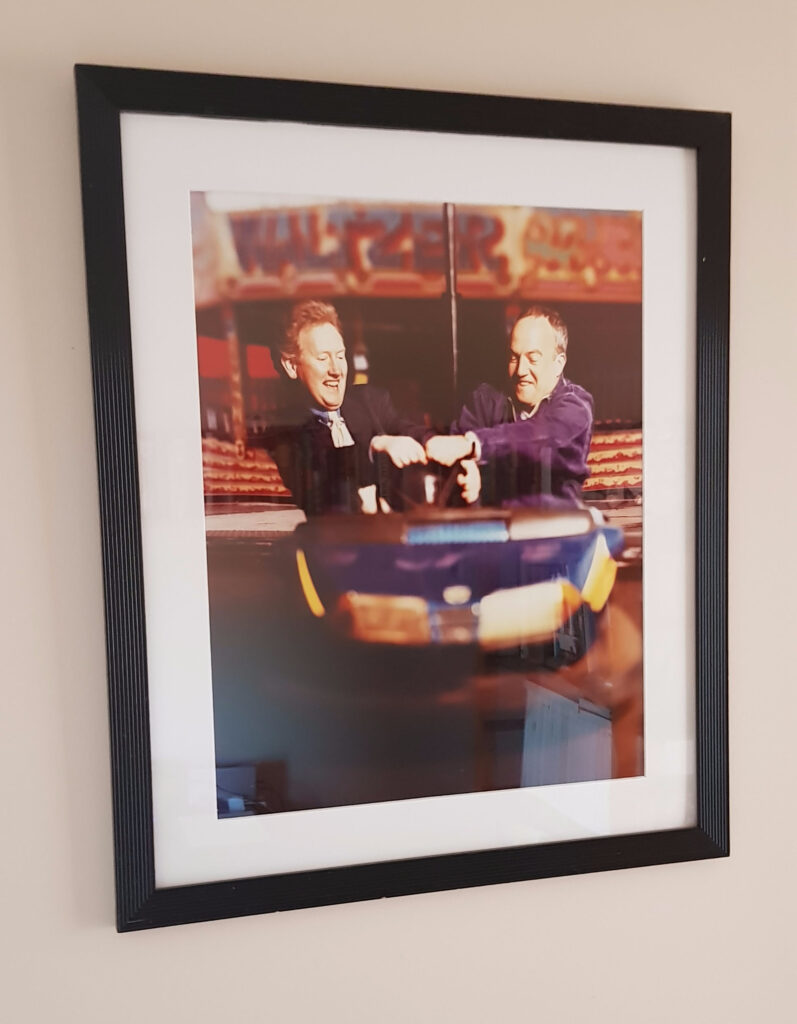
Simon and myself. Fun times.
We used to joke that we would end up as ‘piss-stained old men sharing a caravan at Seton Sands’.
Well it looks like I’ll be there on my own.
He used to say to Ian at the staff meetings to ‘leave them on a high’. Well he left us, and we’re still talking about how he went.
Ian said to me you need to write about Simon because most of the people at The Union have never met him. Well that’s a shame, because everyone should have a Simon in their lives.
Andrew Lindsay, now retired, is a founder of and shareholder in The Union. He was Creative Director of the agency for over 20 years.